Comparison test Kawasaki Z900, Suzuki GSX-S750 and Yamaha MT-09: Election of the best Japanese "maxi-mid-size" roadster
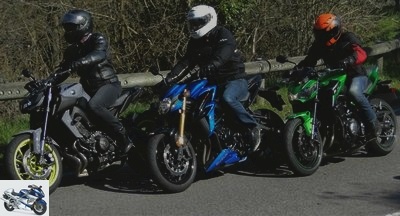
In 2017, Kawasaki further strengthens its bestseller and launches its Z900 in the three legs of the MT-09, updated by Yamaha. Suzuki stays true to its signature "seven-and-a-half" displacement with its new GSX-S750. MNC compares these three new Japanese roadsters … neither maxi, nor "mid-size" ?
Z900 Vs GSX-S750 Vs MT-09 page 3: More like Z900, GSX-S750 or MT-09 ?
The all new Z900 makes efforts to accommodate its rider as well as possible: its saddle is particularly low, its two levers are adjustable in spacing (brake only on the two rivals, see the practical aspects sheet on the next page) and the left is incredibly easy to pull for a "big cube" thanks to its assisted anti-slip clutch.
Impressive because very rounded, the 17-liter tank the Kawasaki finally spreads the thighs a little less than that of 16 liters installed on the Suzuki. Skillfully taking advantage of its 3-cylinder, the Yamaha is much thinner than the two 4-legs … Its tank could even have been less flared in order to carry more fuel (14 l) !

With its high, flat and wide handlebars (52 cm between the two hands, 50 on the Z and 46 on the GSX-S), the MT-09 cultivates its attitude of "Supermotard". The knee flexion is much less than on the Suzuki and Kawasaki. It is on the latter that the legs are the most bent, even when the driver is backing up as far as possible … The purchase of an optional high saddle will be one to think about for the big "big rollers".
On the Suzuki, the saddle is by far the softest … But it is also the thinnest and the shortest, so that the – middle of the – buttocks tires more quickly than on the less creamy but larger saddle of the MT-09. On long distance, we even wonder if we do not prefer the Z board on which we can at least change position. !

Thanks to its featherweight and better turning radius, the MT is by far the easiest to handle with the engine off. Then comes the Z whose weight 3 kg less than that of the GSX-S seems less high placed. The Kawa requires half a front tire more than the Yam to turn around, but a half less than the Suz.
The Hamamatsu machine then tries to recover with its gadgets: the "Easy start" starter which does not require you to keep the button pressed until the engine starts, then the "Low RPM assist" which increases the engine speed to let go of the clutch. But nothing helps: the Suzuki seduces us less at the very beginning of driving.
Site takes orders
What destabilizes the most about the Suzuki, when compared directly to its opponents, is its significantly narrower handlebars (76 cm measured from end to end by MNC, 81 on the MT and 82 on the Z) and curved, which must be remembered when entering bends at low speed. The Suz engages slightly under 20 km / h while the Kawa and the Yam remain perfectly neutral, whatever the speed..
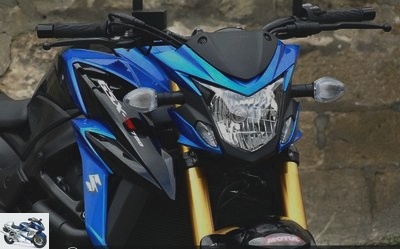
The GSX-S750 partially makes up for it thanks to its non-adjustable suspensions, of course, but well adjusted. In comparison, the Kawasaki shock absorber is harder, as is often the case on Akashi productions. However the saddle of the Zed does not allow to absorb big shocks…
Conversely, the MT easily absorbs the irregularities encountered in town. Its calibration fork revised for 2017 is more resistant to small braking strokes than the old version, but it sinks more generously than its two competitors on the brakes with “blood orange” fire..

Side engine approval in town, the MT-09 is almost on a par with the 4-cylinder. Its 3-cylinder is not quite as flexible because it does not accept to restart from idle on the last two reports, but relaunches without flinching around 2000 rev / min. Who will really complain ?
On the other hand, we can blame the Yamaha gearbox more openly for its selection that is a little too rough. It is all the more regrettable that the quickshifter lends itself rather well to urban use, provided you do not open the throttle too wide in low revs: this can cause jolts..
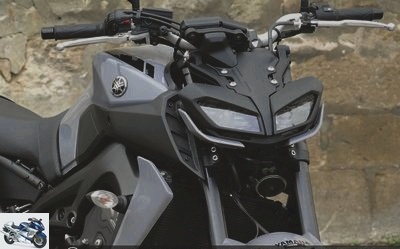
Widely criticized on the first generation of CP3, the injection is proving as pleasant as those of the two rivals. The Suzuki even seemed a bit more bumpy in the mid-range! On the Yamaha, however, be careful to select the mapping mode that matches your driving style or your mood..
In mode B, the softest, the 3-cylinder is perfectly docile under 5000 rev / min. It was only entered the second half of the tachometer – digital! – that the engine regains all its character. In "Standard" mode, the reactions are already more frank from the small gas openings…
Driving modes, user manuals…
By selecting mode A, the pilot ensures even more tonic acceleration. So much so that he must then carefully measure the rotations of the right wrist to blend in with the busy traffic of a large city and not to be noticed by the police..
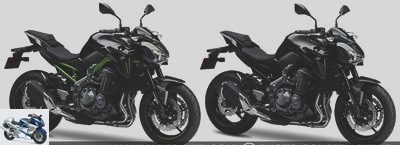
The other "nine hundred" requires the same type of mastery, as the take-offs or the times are muscular, from 3500 rpm! Paradoxically, some will appreciate the engine of the "seven-and-a-half", more hollow in the low and mid-revs, which limits the risks of blowing half of the points of its license with the slightest rotation of the right handle…
On the Z900, the only machine to be devoid of traction control, you must also be careful not to overuse the rear tire as soon as it comes out of the garage: the D214 is responsible for passing more torque and power to the ground than its S20 colleagues. (MT) and S21 (GSX-S), while it takes longer to heat up…
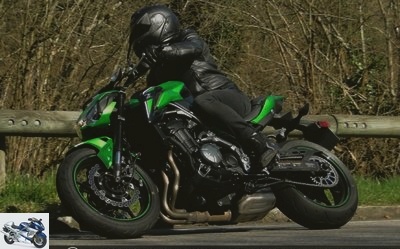
Useless for experienced riders, the traction control would be reassuring for those who have just completed their two-year "A2" period on a machine far less capable than the Z900. They should therefore be careful at the start with cold tires and / or on slippery roads..
On the Suzuki, Site only felt the traction control regulating the engine speed once on a slightly greasy portion of the road. Set to the third, most intrusive notch, the traction control acted smoothly without MNC feeling the rear wheel slip away. Then set to mode 1, it no longer intervened.
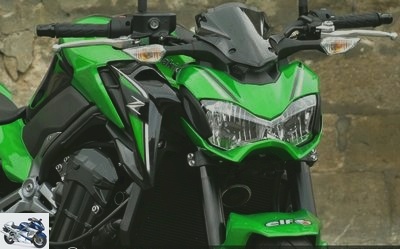
On the MT-09, interventions – a hint less gentle – traction control were much more frequent because of the explosiveness of the 3-cylinder … and the lightness of the Yamaha, especially its front wheel which has quickly leave the ground, turn less quickly than the rear wheel, so wake up the TCS…
Quite quickly moreover, the Journal moto du Net decided to deactivate the traction control: the driving conditions were not far from perfect with a strong sun, a small twenty degrees in the air, roads unobstructed and relatively clean !
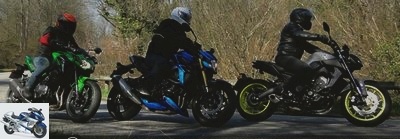
On the road, the MT-09 pilot must take care to move forward on his machine when he engages mode A of his machine and when he plunges himself into "Arsouille" mode. By standing too far back, full acceleration in the first three gears causes the front wheel to lose its steering function … It is hard to believe that the mill only develops 115 hp !
The revivals of the Yamaha are thus the most sensational! And the recovery tests carried out by MNC are clear: the light MT holds the high dragee to the heaviest Zed in low revs, even allowing itself to be ahead of it by half a wheel at around 5000 rpm….
The 900 make miseries for the 750
Beyond, however, the Yamaha is irresistibly overwhelmed by the Kawasaki and its beefier 4-cylinder in the towers … The 4-cylinder continues to tow – vibrating – more and more loudly while the CP3 begins to level off then surrender. A quickshifter can effectively relaunch the Yam, but not return to the Kawa.
Although more linear than on the Blue from Iwata, the "Zpectacular" acceleration of the Green from Akashi also makes it possible to perfect its rear wheels. You just have to pull your butt back against the backrest and accelerate fully in the first two gears to feel the front wheel take off from the ground and fly away … not too high, eh? Better to keep your foot on the brake pedal.

And the GSX-S750 in all of this? Despite the fierce length of its "small" 4-cylinder, the "Yellow" of Hamamatsu cannot compete with the big cubes. To stay in contact with the two 900s during the tests carried out on the fourth gear, MNC had to drop one speed on the 750 (therefore 3rd). That is to say !
It is indeed necessary to wait for approximately 8000 rev / min – that is to say 2000 revolutions more than on the Kawa – to benefit from the full potential of the mill: once this milestone has been crossed, the sound and the rage of the Suzuki become "extraordian"! Question sensations, the pilot of the GSX-S then has nothing to envy his two comrades on MT and Z.

The desire not to cannibalize the GSX-S1000 and the industrial interest that Suzuki has in remaining on a (re) known displacement are understandable. Respectable, its posture is not respected by the competition which continues to inflate its engines, while they themselves offer "Thousands". In the future, Suzuki may have to concede a few extra cubic centimeters and horsepower to its "mid-size" roadster. Or lower your bill by a few euros ?!
Another modification Site would gladly make to the Suzuki: wider, flatter handlebars, which would make the front end less physical in the twisty. The GSX-S750 indeed requires much more commitment than the MT-09 which feasts on successions of small bends or hairpins, followed closely by the obvious Z900 … Less lively, the GSX-S is made again pick up.
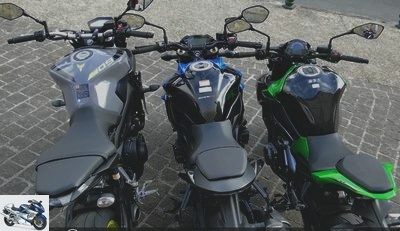
In front, the Yamaha and the Kawasaki compete for the head mainly according to the coating. On smooth roads, the front axle of the Zed makes it possible to enter a curve harder and to improvise more easily than that of the MT whose reactions, especially when releasing the brakes, are more marked and reduce the precision of the trajectories..
Likewise when accelerating, the Kawasaki’s rear axle wedges earlier and more firmly than that of the Yamaha. The latter is more compact … perhaps because of the wilder arrival of the cavalry ?! Still, the Z900 has the advantage. Much lighter and better suspended than the Z800, the new Kawa will seduce the many "Zedists" of France !

On the other hand, the bikers who did not appreciate the behavior of the old Zed on the bumpy will not be much more seduced by the new one: the Kawasaki roadster remains too dry to erase all the defects of the road. The handlebars end up jerking, the rear wheel lacking grip … For once, we are more comfortable on the MT.
By caricaturing, we can estimate that the pilot, heckled on the bad roads with the handlebars of the Z900 and strolled on the most beautiful at the controls of the MT-09, is overall more satisfied with the behavior of the GSX-S750. On the latter, he can trace "all" his roads at good speed, without worrying about bumps, hollows or flats..
Road-proof, smooth and bumpy…
It is only by trying to compete with the Z and the MT on their favorite terrain that the "Gexesse" risks not making the weight: the machine actually gives the impression of breaking up when it is really carved. . Its mass is particularly felt on changes of direction and angle, as was the case on the Z … older generations !
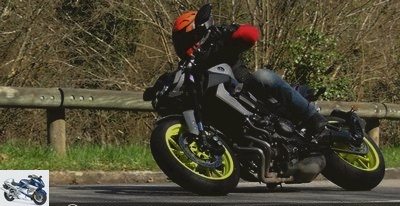
Under braking, however, it is the new Suzuki that wins all the votes, especially as regards the rear, finely dosed and very powerful. The MT is not far in this area while the Z requires a little too much pressure on the right pedal to be as pleasant and precise as its competitors..
A little less biting than on the other two bikes, the front brake of the Zed will still allow the good rider – the one who sees a curve, takes the right lever and dives – to apply the brakes to the bad rider who was playing it on the cafe terrace with its radially fixed stirrups – that one when he sees a curve, he takes the right lever and dives, but … For road use, all three machines brake hard enough.

For highway use, the MT-09 is the most suitable mount. more indicated less contraindicated: stalled at 130 km / h on the last report, the 3-cylinder purrs under 5500 rpm and does not distill any vibration. The saddle of the Yam offers a semblance of comfort compared to that of the too hard Kawa and that of the Suz too thin and short…
The GSX-S750 is also devoid of sizzling while at this cruising speed, its 4-legged grinds to almost 6000 rpm. On the Z900, the engine spins just above 5,500 rpm. The gums and weights of the footrests isolate the feet from vibrations. Heels must not stick to the machine !
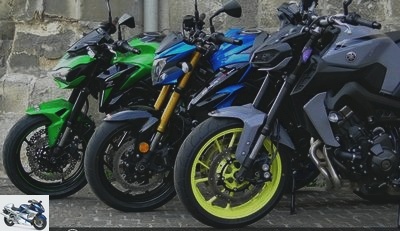
To help out a pedestrian for a few kilometers or to take a – courageous – passenger for several kilometers, on the other hand, the Yamaha is not recommended: if the passenger seat is the most accessible because at the same level as that of the pilot, the footrests are much less because placed too high !
The duo is hardly less unacceptable on the Kawasaki this time because of the ridiculous jump seat crossed, what is more, by unpleasant vibrations from 5000 rpm … Finally, it is on the Suzuki that the "co-driver" s’ does the least badly: his buttocks are – relatively – well received and his legs are not too bent.

No need to fumble along the rear loop or below for grips or even small notches: there are none on any of the three roadsters. To hold a bag elsewhere, you will have to be content with the lugs at the end of the passenger footrest plates…
On the practical side, the Suzuki stands out by agreeing to take on board, in addition to the mandatory yellow vest, a medium-sized U (disc lock only on the Kawa and the Yam). Likewise, the Suz has the best autonomy…
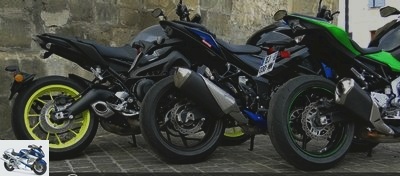
Taking into account our average consumption during this comparison (see the balance sheet in the right column), the GSX-S exceeds – just barely – 300 km with a full 17 liters while the Z plays the blow of the breakdown two terminals before 290 km (with 16 l). The MT with its small 14 l canister reaches 250 km all round.
Despite this fine finish, the Suzuki did not win. Based on the latest criteria studied, a tandem bike equipped with deep side bags would allow two to go even further, without consuming a single drop of unleaded Super. !
Verdict: at the polls, citizens !
Certainly, Suzuki has the clearest offer from Japanese manufacturers with a GSX-S750 and a 1000, two machines between which the "tattooed" Hamamatsu will not hesitate for long, if only because of their prices. : count € 12,699 for the "Mille" and € 8,899 for the "seven-and-a-half" (+ € 200 in Full Black for both models).
But for bikers open to other Japanese brands, the two other models of the day are more interesting. In this new category of "maxi-mid-size" roadster, the GSX-S750 bows against the nine hundred more efficient but displayed at the same price…
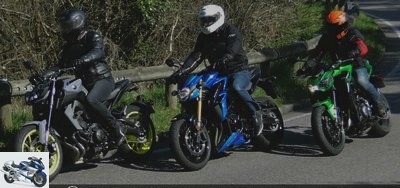
At Kawasaki let’s face it, the Z900 is so successful that it is likely to eclipse the Z1000. Akashi’s "New without aids" roadster perfectly matches the Zed spirit: a cheap motorcycle, with a natural riding position, equipped with a large expressive engine … and now equipped with a chassis at the height.
More sophisticated and more explosive than the Kawasaki, but not more efficient – even less on a beautiful road – and still as offbeat in terms of style and ergonomics, the MT-09 which was until then the only 900 on the market fell on a rival Zacree … At MNC, we can recount the votes, it’s 50/50: your newsletter will make the difference !
Related articles
-
Comparison test Kawasaki Z900, Suzuki GSX-S750 and Yamaha MT-09: Election of the best Japanese maxi-mid-size roadster In 2017, Kawasaki further…
-
Comparison test Kawasaki Z900, Suzuki GSX- S750 and Yamaha MT-09: Election of the best Japanese maxi-mid-size roadster In 2017, Kawasaki further…
-
Comparison test Kawasaki Z900, Suzuki GSX-S750 and Yamaha MT-09: Election of the best Japanese maxi-mid-size roadster In 2017, Kawasaki further…
-
Comparison test Kawasaki Z900, Suzuki GSX-S750 and Yamaha MT-09: Election of the best Japanese maxi-mid-size roadster In 2017, Kawasaki further…
-
Comparison test BMW F 700 GS Vs Kawasaki ER-6f Vs Yamaha Tracer 700: on the road ! To complete our first test of the Tracer 700, Yamaha’s new…
-
Comparison test Kawasaki Z750, Suzuki GSR 750 and Yamaha FZ8: the roadster war Slowly but surely, the Japanese resistance is organizing in order to push…
-
Comparison test Kawasaki Z750, Suzuki GSR 750 and Yamaha FZ8: the roadster war Slowly but surely, the Japanese resistance is organizing in order to push…
-
Japanese roadster comparative test: CB1000R, Z1000 or GSX-S1000 ? Invested last year by several novelties, the maxiroadster segment remains dominated by…
-
Comparison test of supersports: Honda CBR 600 F, Kawasaki ZX-6R, Suzuki GSX-R 600, Yamaha YZF 600 R
Comparison test of supersports: Honda CBR 600 F , Kawasaki ZX-6R , Suzuki GSX-R 600 , Yamaha YZF 600 R Let’s twist again Wake up people. In the 600s it’s…
-
Comparison test Powercruiser Kawasaki VN 2000 , Suzuki Intruder M 1800 R , Yamaha XV 1900 Midnight Star Punchtime Nobody distributes more displacement…